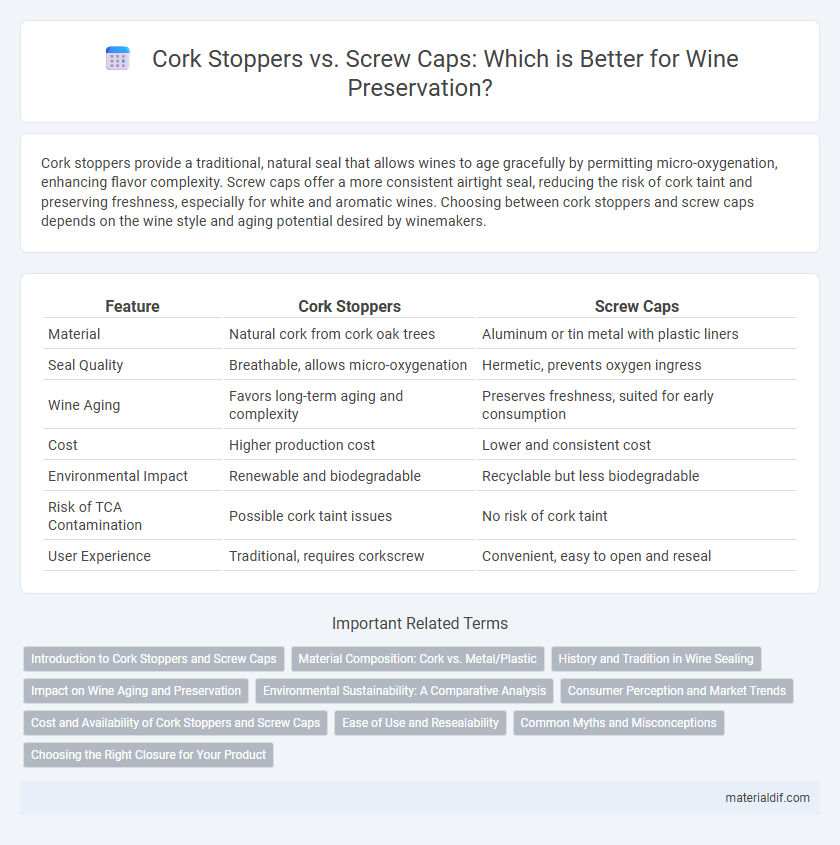Cork stoppers provide a traditional, natural seal that allows wines to age gracefully by permitting micro-oxygenation, enhancing flavor complexity. Screw caps offer a more consistent airtight seal, reducing the risk of cork taint and preserving freshness, especially for white and aromatic wines. Choosing between cork stoppers and screw caps depends on the wine style and aging potential desired by winemakers.
Table of Comparison
| Feature | Cork Stoppers | Screw Caps |
|---|---|---|
| Material | Natural cork from cork oak trees | Aluminum or tin metal with plastic liners |
| Seal Quality | Breathable, allows micro-oxygenation | Hermetic, prevents oxygen ingress |
| Wine Aging | Favors long-term aging and complexity | Preserves freshness, suited for early consumption |
| Cost | Higher production cost | Lower and consistent cost |
| Environmental Impact | Renewable and biodegradable | Recyclable but less biodegradable |
| Risk of TCA Contamination | Possible cork taint issues | No risk of cork taint |
| User Experience | Traditional, requires corkscrew | Convenient, easy to open and reseal |
Introduction to Cork Stoppers and Screw Caps
Cork stoppers, derived from the bark of the cork oak tree, have been traditionally used for sealing wine bottles due to their natural elasticity and airtight properties. Screw caps, made from aluminum, provide a consistent and reliable seal that prevents oxidation and spoilage, favored in modern winemaking for ease of use and preservation. The choice between cork stoppers and screw caps impacts wine aging, flavor development, and consumer perception in the wine industry.
Material Composition: Cork vs. Metal/Plastic
Cork stoppers are made from the bark of the cork oak tree, offering a natural, renewable, and biodegradable material that allows for gradual oxygen exchange, enhancing wine aging. Screw caps, typically composed of aluminum or a combination of metal and plastic liners, provide a consistent, airtight seal that prevents oxidation and preserves wine freshness. Each material composition affects wine preservation differently, with cork allowing micro-oxygenation and screw caps ensuring airtight protection.
History and Tradition in Wine Sealing
Cork stoppers have been the traditional choice for wine sealing for over 3,000 years, originating from the Cork oak trees in the Mediterranean region, symbolizing heritage and authenticity in winemaking. Screw caps, introduced in the 20th century, offer a modern alternative that ensures airtight seals and consistency, yet lack the ceremonial and tactile connection associated with cork. The historical significance of cork lies in its natural elasticity and breathability, which has shaped historic wine aging practices and cultural rituals around wine consumption.
Impact on Wine Aging and Preservation
Cork stoppers provide a natural micro-oxygenation that enhances the complex aging process of wine, allowing subtle flavor development and improved bouquet over time. Screw caps create a near-hermetic seal, preserving freshness and preventing oxidation, which is ideal for white wines and wines meant for early consumption. Studies in Cork show that while cork enables gradual maturation, screw caps offer consistent preservation, influencing winemakers' choices based on wine style and intended aging potential.
Environmental Sustainability: A Comparative Analysis
Cork stoppers are biodegradable and harvested from renewable cork oak forests, supporting carbon sequestration and biodiversity, which makes them a highly sustainable packaging choice. Screw caps, typically made from aluminum, require significant energy to produce and are less biodegradable, raising concerns about resource use and recycling efficiency. Life cycle assessments consistently highlight cork's lower environmental footprint compared to the energy-intensive production and limited recyclability of screw caps in wine bottle closures.
Consumer Perception and Market Trends
Cork stoppers maintain a strong consumer preference in Cork due to their traditional appeal and perceived sustainability, which aligns with growing environmental consciousness in the wine market. Screw caps, however, are gaining market share in Cork for their reliability in preserving wine freshness and reducing cork taint risks, appealing especially to younger, urban consumers. Market trends in Cork indicate a gradual shift towards screw caps, particularly in premium and export segments, while cork remains dominant in artisanal and heritage wine collections.
Cost and Availability of Cork Stoppers and Screw Caps
Cork stoppers for wine bottles typically cost more than screw caps due to the natural harvesting and processing of cork oak bark primarily sourced from the Cork region of Portugal and Spain. Screw caps, often made from aluminum or tin, are widely available as a cost-effective alternative, with consistent pricing and global manufacturing accessibility. The cost difference influences many small wineries in regions like Cork, Ireland to prefer screw caps for their affordability and reliable supply.
Ease of Use and Resealability
Cork stoppers offer a traditional opening experience but can be challenging to remove without a corkscrew, limiting ease of use compared to screw caps. Screw caps provide effortless opening and reclosing, enhancing resealability and preserving wine freshness for longer periods. This makes screw caps a preferred choice for convenience and wine preservation in everyday settings.
Common Myths and Misconceptions
Cork stoppers are often believed to cause "cork taint," but advances in cork production have significantly reduced this issue, making natural cork a reliable closure. Screw caps are mistakenly thought to impair wine aging, yet they offer superior airtight seals that preserve freshness and prevent oxidation. Both closures have distinct advantages, and choosing between cork and screw caps depends on wine style and consumer preference rather than misconceptions.
Choosing the Right Closure for Your Product
Selecting the ideal closure for your product involves weighing the benefits of cork stoppers and screw caps in Cork's wine industry. Cork stoppers, sourced from sustainable cork oak forests, offer traditional appeal and natural breathability that enhances wine aging. Screw caps provide a consistent, airtight seal that prevents oxidation and preserves freshness, favored for modern wines requiring minimal aging.
Cork stoppers vs Screw caps Infographic

 materialdif.com
materialdif.com